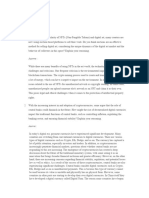Tugas 1 Bing Niaga
Tugas 1 Bing Niaga
Uploaded by
Mei JustikaCopyright:
Available Formats
Tugas 1 Bing Niaga
Tugas 1 Bing Niaga
Uploaded by
Mei JustikaOriginal Title
Copyright
Available Formats
Share this document
Did you find this document useful?
Is this content inappropriate?
Copyright:
Available Formats
Tugas 1 Bing Niaga
Tugas 1 Bing Niaga
Uploaded by
Mei JustikaCopyright:
Available Formats
NIM : 053146495
NAMA : MEI JUSTIKA ZAHARAH
PRODI : ADMINISTRASI BISNIS
1. Given the rise in popularity of NFTs (Non-Fungible Tokens) and digital art,
many creators are now using auction-based platforms to sell their work. Do you
think auctions are an effective method for selling digital art, considering the
unique dynamics of the digital art market and the behavior of collectors in this
space? Explain your reasoning.
First, auctions can make the price of digital artwork rise. If many collectors compete
to obtain a work, the price can increase, especially if the work is considered special or
rare.
Apart from that, auctions can also make more people interested and interested in
certain works. The open process can also make collectors feel more confident because
they can see directly how prices are formed.
Another thing, auctions can be a great way to reward digital works of art. Although
initially many were doubtful about the value of digital art, through auctions it can be
more recognized and appreciated by the collector community.
Furthermore, auctions can also help digital works of art become more widely known.
Because the advertisement can be distributed everywhere, it can penetrate the
international market and reach collectors from various parts of the world.
But yes, there are definitely challenges too. One of them is about copyright and the
possibility of duplication of works. So it is important to ensure that artists and auction
platforms properly protect copyright so that their digital artwork is not easily
duplicated or faked.
So, even though auctions can be an okay option for selling digital art, they still have
to be handled carefully and ensure that all parties are protected in the process.
2. With the increasing interest in and adoption of cryptocurrencies, some argue
that the role of central banks could diminish in the future. How might the rise of
decentralized digital currencies impact the traditional functions of central banks,
such as controlling inflation, regulating the banking sector, and ensuring
financial stability? Explain your reasoning.
Decentralized digital currencies, such as Bitcoin or Ethereum, confuse central banks.
The thing is, this digital currency is not controlled by a central bank or banking
system that we are familiar with.
Regulating Inflation: Usually the central bank has an important role in regulating the
amount of money in circulation so that inflation remains under control. However, with
the existence of decentralized digital currencies, central banks lose control over the
amount of digital currency in circulation. As a result, it becomes difficult for them to
control inflation in the economy.
Regulating Banks: Apart from controlling inflation, the central bank is also tasked
with supervising banks so that the financial system remains stable. However, with
more and more people using digital currency, many can also access financial services
without going through a bank. So, central bank control over banks is reduced, and this
can increase financial risks due to lack of supervision.
Guarantee Financial Stability: The central bank is also tasked with maintaining
overall financial stability. However, with digital currency prices fluctuating sharply,
this could disrupt financial stability which is supervised by the central bank.
In any case, decentralized digital currencies confuse central banks. They have no
control over this, because the technology allows transactions to be carried out without
the need for traditional financial institutions to intervene. So, the central bank must
think hard about maintaining economic stability without having direct control over
this digital currency.
You might also like
- DokumenDocument2 pagesDokumenRomy NeirNo ratings yet
- Tugas 1 BAHASA INGGRIS NIAGADocument3 pagesTugas 1 BAHASA INGGRIS NIAGArimmatulkhasanah2209No ratings yet
- Jawaban B.inggris ABDBI 4201.123Document1 pageJawaban B.inggris ABDBI 4201.123fransiskasiagian5No ratings yet
- Tugas 1 Rizal Lufi Nim 048779983 Bahasa Inggris NiagaDocument3 pagesTugas 1 Rizal Lufi Nim 048779983 Bahasa Inggris NiagadikafaNo ratings yet
- Tugas 1 Bahasa Inggris Niaga (Anita Septian 049014138)Document3 pagesTugas 1 Bahasa Inggris Niaga (Anita Septian 049014138)Anita SeptianNo ratings yet
- Mojmír Hampl: Central Banks, Digital Currencies and Monetary Policy in Times of Elastic MoneyDocument3 pagesMojmír Hampl: Central Banks, Digital Currencies and Monetary Policy in Times of Elastic MoneyWael HassanNo ratings yet
- Bahasa Inggris Niaga Tugas 1Document2 pagesBahasa Inggris Niaga Tugas 1anjanirahayu29No ratings yet
- Inggrisniaga 1Document2 pagesInggrisniaga 1crew13915No ratings yet
- Mega Puspatika - 050824712 - Matkul - Adbi420101 - Semester 1 Tugas 1Document3 pagesMega Puspatika - 050824712 - Matkul - Adbi420101 - Semester 1 Tugas 1zara60973No ratings yet
- NITA LISTIANA Inggris Niaga - 049021695Document2 pagesNITA LISTIANA Inggris Niaga - 049021695farelbyan0No ratings yet
- Tugas 1 Bahasa InggrisDocument2 pagesTugas 1 Bahasa Inggrissutinimd24No ratings yet
- Tugas Tutorial 1 - Bahasa Inggris NiagaDocument3 pagesTugas Tutorial 1 - Bahasa Inggris NiagaDidi SamayudinNo ratings yet
- Tugas Tuton 1 Bahasa Inggris NiagaDocument2 pagesTugas Tuton 1 Bahasa Inggris NiagaTri WahyuniNo ratings yet
- The Good, The Bad, and The UglyDocument13 pagesThe Good, The Bad, and The UglyTanvir AhmedNo ratings yet
- Session 3 - Yuna JunitaDocument2 pagesSession 3 - Yuna Junitamhdridhoh23No ratings yet
- Cryptocurrency Chapter 1Document6 pagesCryptocurrency Chapter 1Myra ChoyyNo ratings yet
- Yanwar Arifin 048384381 Tugas 1 Adbi4201 Bahasa Inggris NiagaDocument5 pagesYanwar Arifin 048384381 Tugas 1 Adbi4201 Bahasa Inggris NiagaYanwar ArifinNo ratings yet
- Binggris NiagaDocument2 pagesBinggris NiagainnaqurotulainNo ratings yet
- TUGAS 1 - Bahasa Inggris Niaga (ADBI4201)Document3 pagesTUGAS 1 - Bahasa Inggris Niaga (ADBI4201)rianandikamei2002No ratings yet
- What Is Bitcoin? How Can We Earn Through Bitcoin?Document4 pagesWhat Is Bitcoin? How Can We Earn Through Bitcoin?Keep SilenceNo ratings yet
- Although Cryptocurrencies Awareness Has Increased Ever Since This Term First Was Out and I Do Think That There Could Be A Reduction of Depository InstitutionsDocument1 pageAlthough Cryptocurrencies Awareness Has Increased Ever Since This Term First Was Out and I Do Think That There Could Be A Reduction of Depository InstitutionsIndira AlfonsoNo ratings yet
- Is The End of Cash CloseDocument4 pagesIs The End of Cash Closemarine.allaireNo ratings yet
- Cryptocurrency for Beginners: Complete Crypto Investing Guide with Everything You Need to Know About Crypto and AltcoinsFrom EverandCryptocurrency for Beginners: Complete Crypto Investing Guide with Everything You Need to Know About Crypto and AltcoinsRating: 4 out of 5 stars4/5 (14)
- Bitcoin: The Money RevolutionDocument8 pagesBitcoin: The Money Revolutionspiro1944No ratings yet
- Crypto Currencies and Their Impact On Economy and Banking SystemsDocument18 pagesCrypto Currencies and Their Impact On Economy and Banking SystemsZohaib AliNo ratings yet
- TeksDocument2 pagesTeksdikafaNo ratings yet
- Adelia 1 (049398526) B.inggrisDocument2 pagesAdelia 1 (049398526) B.inggrisAdelia SakinahNo ratings yet
- Tugas 1 Bahasa Inggris NiagaDocument4 pagesTugas 1 Bahasa Inggris NiagaRizki 03No ratings yet
- Tugas 1 Bahasa Inggris NiagaDocument3 pagesTugas 1 Bahasa Inggris NiagadikafaNo ratings yet
- Will This Rise in Cryptocurrency Lead To The Downfall of The Global EconomyDocument4 pagesWill This Rise in Cryptocurrency Lead To The Downfall of The Global Economycreativecrafter15No ratings yet
- Bitcoin: The Money RevolutionDocument8 pagesBitcoin: The Money Revolutionspiro1944No ratings yet
- Bitcoin: The Money RevolutionDocument8 pagesBitcoin: The Money Revolutionspiro1944No ratings yet
- Going CashlessDocument5 pagesGoing CashlessАнна БіємськаNo ratings yet
- INTRODUCTION TO CRYPTOCURRENCY: A Guide to Understanding cryptocurrencyFrom EverandINTRODUCTION TO CRYPTOCURRENCY: A Guide to Understanding cryptocurrencyNo ratings yet
- Bitcoin and Cryptocurrency: The Ultimate Cryptocurrency Trading and Investing GuideFrom EverandBitcoin and Cryptocurrency: The Ultimate Cryptocurrency Trading and Investing GuideRating: 5 out of 5 stars5/5 (6)
- ADBI4201Document2 pagesADBI4201icap7292No ratings yet
- Meets Economics Project Class 12Document63 pagesMeets Economics Project Class 12Meet RupareliyaNo ratings yet
- Essay Monetary and Finantial LawDocument4 pagesEssay Monetary and Finantial Lawmarine.allaireNo ratings yet
- CRYPTO TRADING: A Comprehensive Guide to Mastering Cryptocurrency Trading Strategies (2023)From EverandCRYPTO TRADING: A Comprehensive Guide to Mastering Cryptocurrency Trading Strategies (2023)No ratings yet
- B. Inggris NiagaDocument2 pagesB. Inggris NiagaAnita SeptianNo ratings yet
- Becoming Millionaire Through CryptoDocument55 pagesBecoming Millionaire Through CryptoBikash Khanal100% (7)
- Tugas 1 Bahasa Inggris NiagaDocument3 pagesTugas 1 Bahasa Inggris Niagaputrichyntia1998No ratings yet
- Cash Matters: The Power and Persistence of Physical CurrencyFrom EverandCash Matters: The Power and Persistence of Physical CurrencyRating: 5 out of 5 stars5/5 (1)
- CRYPTO INVESTING GUIDE The Ultimate Safe and Secure Guide To Buy and Trade Digital CurrenciesDocument65 pagesCRYPTO INVESTING GUIDE The Ultimate Safe and Secure Guide To Buy and Trade Digital Currenciesroyala1carsNo ratings yet
- BIT Coin Report 1 Intro To Bit Coin Version 1.0 Completed 17oct2017Document23 pagesBIT Coin Report 1 Intro To Bit Coin Version 1.0 Completed 17oct2017Firdaus TanNo ratings yet
- Bitcoin and Digital Currency for Beginners: The Basic Little GuideFrom EverandBitcoin and Digital Currency for Beginners: The Basic Little GuideRating: 4.5 out of 5 stars4.5/5 (2)
- The Disruptors: How Cryptocurrencies are Shaking Up Traditional FinanceFrom EverandThe Disruptors: How Cryptocurrencies are Shaking Up Traditional FinanceNo ratings yet
- Tugas Tutorial 1 - Bahasa Inggris NiagaDocument3 pagesTugas Tutorial 1 - Bahasa Inggris Niagapurbaju26No ratings yet
- Chris Giancarlo Remarks Davos PDFDocument15 pagesChris Giancarlo Remarks Davos PDFThe BlockNo ratings yet
- Advantages and Disadvantages of Digital Currency Prospects For DevelopmentDocument5 pagesAdvantages and Disadvantages of Digital Currency Prospects For DevelopmentGuest GuestNo ratings yet
- Crypto CurrencyDocument14 pagesCrypto CurrencyALAY SINGHNo ratings yet
- Why Bitcoin, Ethereum and Cryptocurrencies?: A Son’s Explanation to His FatherFrom EverandWhy Bitcoin, Ethereum and Cryptocurrencies?: A Son’s Explanation to His FatherNo ratings yet
- Cryptocurrency by Reginald P. PhillipsDocument39 pagesCryptocurrency by Reginald P. Phillipsandi mandiNo ratings yet
- Cryptocurrency - by - Reginald - P. - Phillips @tradingpdfgratisDocument39 pagesCryptocurrency - by - Reginald - P. - Phillips @tradingpdfgratistincho1980No ratings yet
- TEST - Unit 2 The Allocation of ResourcesDocument4 pagesTEST - Unit 2 The Allocation of ResourcesJoe AmirthamNo ratings yet
- A Short Review of The Bertrand Paradox - How Realistic Is It?Document7 pagesA Short Review of The Bertrand Paradox - How Realistic Is It?Zakaria Cassim100% (2)
- Warren E. Buffett, 2015Document20 pagesWarren E. Buffett, 2015mashri1No ratings yet
- Inside Ict IntradayDocument20 pagesInside Ict Intradaybullscrownfx100% (3)
- Mkt101 Tutorial 5 (Chapters 5 & 6) True or False: B) Price StimuliDocument3 pagesMkt101 Tutorial 5 (Chapters 5 & 6) True or False: B) Price StimuliThan NguyenNo ratings yet
- 2ndyr - 1stF - Intermediate Accounting 1 - 2223Document33 pages2ndyr - 1stF - Intermediate Accounting 1 - 2223hsdownshsalaNo ratings yet
- Appraisal PrinciplesDocument142 pagesAppraisal PrinciplesJenefer Torres SolamilloNo ratings yet
- Price Action Analysis Using The Wyckoff Trading MethodDocument2 pagesPrice Action Analysis Using The Wyckoff Trading MethodSkate DudeNo ratings yet
- Get Paid Upfront To Trade Stocks. by Gregory MannarinoDocument9 pagesGet Paid Upfront To Trade Stocks. by Gregory Mannarinopaulomoreiranuts001No ratings yet
- RelativeStrenghtIndex (RSI) +RSIdivergence SmartRisk 1712234832431Document13 pagesRelativeStrenghtIndex (RSI) +RSIdivergence SmartRisk 1712234832431professordchibsNo ratings yet
- Name: Mercado, Kath DATE: 01/15 Score: Activity Answer The Following Items On A Separate Sheet of Paper. Show Your Computations. (4 Items X 5 Points)Document2 pagesName: Mercado, Kath DATE: 01/15 Score: Activity Answer The Following Items On A Separate Sheet of Paper. Show Your Computations. (4 Items X 5 Points)Kathleen MercadoNo ratings yet
- Tugas 1 - Bahasa Inggris - Shinta Dewi Eka WulandariDocument2 pagesTugas 1 - Bahasa Inggris - Shinta Dewi Eka WulandariRindi AntikaNo ratings yet
- Equity EvaluationDocument20 pagesEquity EvaluationRavi SistaNo ratings yet
- Yustika Adiningsih-F0319141-Mindmap SPM A Chapter 6 Dan 7Document2 pagesYustika Adiningsih-F0319141-Mindmap SPM A Chapter 6 Dan 7yes iNo ratings yet
- Interpretation of ContractsDocument2 pagesInterpretation of ContractsJulia GaddNo ratings yet
- Chapter 5 An Introduction To Cost Terms and PurposesDocument4 pagesChapter 5 An Introduction To Cost Terms and PurposesGosaye DesalegnNo ratings yet
- Marketing Management Business Plan Green Brick ManufacturersDocument27 pagesMarketing Management Business Plan Green Brick ManufacturersShowkatul IslamNo ratings yet
- 11 Valuation of Entrepreneurial VenturesDocument15 pages11 Valuation of Entrepreneurial VenturesSatendra JaiswalNo ratings yet
- Intro To Lease OptionsDocument6 pagesIntro To Lease OptionsShaun Eve100% (1)
- Puyat and Sons Inc. v. Arco Amusement Co.Document2 pagesPuyat and Sons Inc. v. Arco Amusement Co.Gennard Michael Angelo Angeles100% (1)
- Relevant Costing and RevenuesDocument5 pagesRelevant Costing and RevenuesFatemah MohamedaliNo ratings yet
- Prof P. KrishnaDocument26 pagesProf P. KrishnaChetan AgrawalNo ratings yet
- Income Elasticity of DemandDocument12 pagesIncome Elasticity of DemandChloe ClarkNo ratings yet
- Economic SystemsDocument6 pagesEconomic SystemsKarma AkabaneNo ratings yet
- 360 Degree Price Analysis: 180 Degrees 1/2 125.14Document2 pages360 Degree Price Analysis: 180 Degrees 1/2 125.14khangphongnguyengmaiNo ratings yet
- Prelim HandoutDocument12 pagesPrelim HandoutYe RinNo ratings yet
- Material Costing - Theory & Practical Questions-3Document12 pagesMaterial Costing - Theory & Practical Questions-3sakshi.sinha56327No ratings yet
- DMU 20180310-069 Rev1 1 PDFDocument7 pagesDMU 20180310-069 Rev1 1 PDFjason6686pNo ratings yet
- CB2 Formula and Review SheetDocument22 pagesCB2 Formula and Review Sheetpnathvani05No ratings yet
- Management-Control Systems, Transfer Pricing, and Multinational ConsiderationsDocument30 pagesManagement-Control Systems, Transfer Pricing, and Multinational Considerationsthorat82No ratings yet

























































































